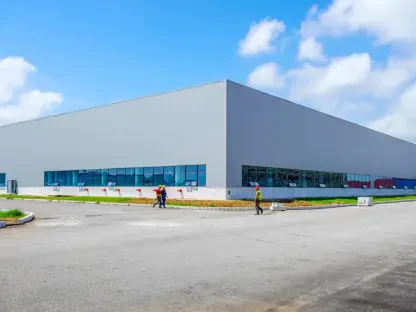In the ever-evolving landscape of global supply chains, warehouses stand as critical junctions where the seamless flow of goods from production to delivery is either made or broken, directly impacting customer satisfaction and a company’s profitability. These facilities are no longer mere storage spaces but dynamic hubs that influence business outcomes. Yet, many operations grapple with inefficiencies stemming from fragmented data and unnoticed productivity losses, often referred to as “missing time.” The financial impact of such blind spots can be staggering, with even small gaps in labor performance draining significant resources. This exploration delves into the transformative potential of data-driven tools, showcasing how they illuminate hidden inefficiencies and pave the way for optimized warehouse performance. By integrating advanced technologies and strategic management practices, businesses can turn operational challenges into competitive strengths, ensuring goods move efficiently while costs remain in check.
The stakes in warehouse management are undeniably high, as these facilities serve as the backbone linking manufacturers, distributors, and logistics providers. Whether it’s ensuring raw materials are ready for production or maintaining precise stock levels for timely deliveries, the efficiency of processes like receiving, storing, and shipping is paramount. However, bottlenecks often emerge due to manual tasks or disconnected systems, creating delays that ripple across the supply chain. Data-driven tools offer a powerful remedy by providing clear visibility into performance metrics, enabling managers to pinpoint and address issues before they escalate. This approach not only streamlines operations but also safeguards the bottom line, transforming warehouses into engines of reliability and speed that meet the demands of a fast-paced market.
Unlocking Potential Through Performance Visibility
Shining a Light on Hidden Losses
A persistent challenge in warehouse management lies in the lack of clear insight into operational performance, where data often remains trapped in isolated systems, obscuring the full scope of productivity. This fragmentation hides critical inefficiencies, such as untracked labor time or “missing time,” which can silently erode profits. Data-driven tools like Warehouse Performance Management (WPM) systems tackle this issue by integrating disparate data sources into a unified view, revealing gaps that were previously invisible. For instance, identifying just 30 minutes of unaccounted time per worker daily could lead to annual savings exceeding $400,000 in a mid-sized facility. Such revelations empower decision-makers to address inefficiencies with precision, ensuring resources are allocated effectively and operational waste is minimized.
The impact of enhanced visibility extends beyond mere cost savings, as it fosters a culture of accountability and continuous improvement within warehouse operations. When performance metrics are transparent, managers can set realistic targets and track progress against them, while employees gain clarity on expectations. Data-driven tools provide the granular detail needed to analyze specific processes—whether it’s excessive travel time during put-away or delays in order picking—and devise targeted solutions. This level of insight is not just about fixing what’s broken; it’s about proactively optimizing workflows to prevent issues from arising. By bridging the gap between raw data and actionable intelligence, these tools lay the groundwork for sustained efficiency gains that resonate across the entire supply chain.
Harnessing Real-Time Insights for Agility
Static reports and delayed feedback are no match for the dynamic nature of warehouse operations, where issues can emerge and escalate within hours. Real-time dashboards, powered by data-driven tools, offer an immediate window into key performance indicators such as order cycle times, labor costs per unit, and equipment utilization rates. This live monitoring capability allows managers to detect anomalies—like a sudden spike in picking errors or a bottleneck at receiving—and respond swiftly before they disrupt the broader workflow. The agility afforded by such tools ensures that operations remain fluid, even under fluctuating demand or unexpected challenges, maintaining service levels without sacrificing efficiency.
Moreover, real-time insights enable a proactive rather than reactive approach to warehouse management, shifting the focus from damage control to strategic planning. By continuously tracking metrics, these dashboards highlight trends that might indicate deeper systemic issues, such as recurring delays in specific zones or underperforming equipment. This forward-looking perspective allows for preemptive adjustments, whether it’s reallocating labor to high-demand areas or scheduling maintenance before a breakdown occurs. The result is a more resilient operation that can adapt to changing conditions while keeping costs and errors in check. Data-driven real-time monitoring thus becomes a cornerstone of modern warehouse efficiency, ensuring that every decision is informed and timely.
Transforming Operations with Cutting-Edge Technology
Building on Robust Core Systems
At the heart of modern warehouse optimization are foundational systems like Warehouse Management Systems (WMS), Labor Management Systems (LMS), and Transportation Management Systems (TMS), which bring structure to complex operations. These platforms replace outdated manual methods, such as spreadsheet tracking, with integrated solutions that consolidate data across receiving, storage, and shipping processes. A unified data environment provides a comprehensive overview of performance, allowing managers to monitor inventory accuracy, labor productivity, and delivery timelines in one place. This integration eliminates guesswork, ensuring that every aspect of the warehouse operates in sync, driving efficiency and reducing the likelihood of costly errors.
The value of these core systems lies in their ability to create a seamless flow of information, breaking down silos that often hinder decision-making. For example, a WMS can optimize storage layouts based on real-time inventory data, while an LMS tracks worker performance to balance workloads effectively. When paired with a TMS, these tools ensure that outbound shipments are coordinated with inbound deliveries, minimizing idle time for trucks and workers alike. Such coordination not only streamlines day-to-day tasks but also builds a foundation for scalability, enabling warehouses to handle increased volumes without proportional cost increases. By anchoring operations in robust, data-driven systems, businesses can achieve a level of control and precision that manual methods simply cannot match.
Embracing Innovation for Strategic Advantage
Beyond core systems, emerging technologies like artificial intelligence (AI), robotics, and the Internet of Things (IoT) are redefining what’s possible in warehouse environments, pushing efficiency to new heights. AI algorithms analyze historical data to predict potential disruptions, such as stock shortages or equipment failures, allowing for preemptive action. IoT devices, meanwhile, enable real-time tracking of goods and assets, ensuring pinpoint accuracy in inventory management. Robotics automates repetitive tasks like pallet stacking or item retrieval, freeing up human workers for more complex roles. Together, these innovations enhance speed and precision, though their success hinges on a balanced integration with skilled labor to maintain flexibility and problem-solving capacity.
The adoption of such cutting-edge tools also positions warehouses to stay ahead in a competitive market, where speed and accuracy are non-negotiable. For instance, IoT-enabled sensors can monitor environmental conditions to protect perishable goods, while AI-driven analytics optimize picking routes to shave seconds off each order. These incremental gains add up, delivering significant reductions in operational costs and improvements in delivery reliability. However, the key to maximizing these technologies lies in strategic implementation—ensuring they complement rather than replace human expertise. This balanced approach allows warehouses to leverage innovation for a strategic edge, meeting customer expectations while maintaining operational harmony and long-term sustainability.
Driving Results with Strategic Data Practices
Implementing Best Practices for Lasting Impact
Adopting data-driven strategies through platforms like WPM can deliver transformative results, with labor efficiency gains of 10-20%, reduced overtime, and lower costs per unit shipped becoming achievable targets. Best practices form the bedrock of these outcomes, starting with the measurement of critical metrics like hidden time and order accuracy. Unifying data across systems ensures a holistic view of operations, while continuous benchmarking against industry standards highlights areas for improvement. Balancing automation with human skills further maximizes efficiency without sacrificing adaptability. These practices, supported by specialized tools, turn raw operational data into tangible, sustainable gains that elevate warehouse performance.
The journey to lasting impact also involves fostering a mindset of iterative refinement, where data isn’t just collected but actively used to drive decisions. For instance, benchmarking cost per unit over time can reveal whether process changes are yielding expected savings, prompting adjustments as needed. Similarly, analyzing labor data helps identify training needs or staffing imbalances, ensuring resources are deployed where they’re most effective. This cyclical process of measurement, analysis, and action ensures that efficiency gains aren’t one-off wins but part of an ongoing evolution. By embedding these data-driven best practices into daily operations, warehouses can maintain a competitive edge, delivering consistent value to the broader supply chain.
Reflecting on Achieved Milestones
Looking back, the adoption of data-driven tools in warehouse management marked a pivotal shift, turning once-static facilities into dynamic centers of operational excellence. The integration of systems like WMS and LMS, alongside innovations such as AI and IoT, addressed long-standing blind spots, from untracked labor time to inefficient workflows. Real-time dashboards provided the agility needed to navigate daily challenges, while strategic practices like benchmarking and data unification delivered measurable savings and service improvements. These advancements redefined efficiency, proving that visibility and technology could transform warehouses into strategic assets.
As the industry continues to evolve, the focus should shift toward scaling these successes, exploring how data-driven insights can further optimize multi-facility networks or integrate with emerging supply chain trends. Investing in employee training to complement technological tools will remain crucial, ensuring that human ingenuity keeps pace with automation. Additionally, businesses should prioritize partnerships with technology providers to stay abreast of innovations that could unlock new efficiencies. Reflecting on past achievements, the path forward lies in continuous adaptation, leveraging data not just to solve today’s challenges but to anticipate tomorrow’s opportunities.









